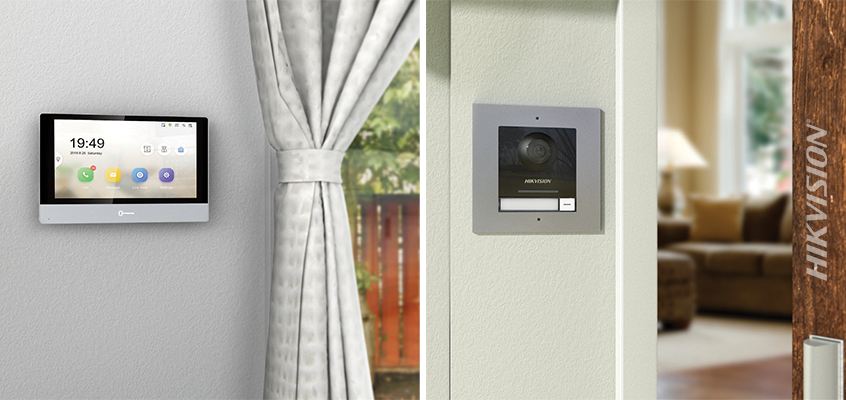Accueillez les visiteurs et contrôlez l'accès aux bâtiments depuis n'importe où

La nouvelle solution d'interphone vidéo IP modulaire de Hikvision vous permet d'accueillir les visiteurs et de contrôler l'accès aux bâtiments de n’importe où. Vous pouvez voir, entendre, parler et accorder l'accès aux personnes à la porte depuis les nouvelles stations intérieures ou de vos téléphones intelligents ou tablettes à l'aide de l'application Hik-Connect gratuite.
Le poste de porte principal offre une fonctionnalité d'interphone vidéo avec une étiquette de nom et un bouton d'appel. Jusqu'à huit modules supplémentaires peuvent être connectés à l'unité principale. Le module porte-nom contient six porte-noms et boutons d'appel supplémentaires. Le module de lecteur de carte permet de déverrouiller la porte à l'aide de cartes RFID ou de télécommandes. Le module clavier vous permet de joindre plus de 500 pièces et vous garantit l'accès par mot de passe. Le module d'affichage répertorie les contacts qui peuvent être sélectionnés et appelés. Les cadres encastrés ou montés en surface peuvent supporter deux ou trois modules verticalement, et plusieurs cadres peuvent être montés de manière adjacente.
La solution d'interphone de Hikvision offre les avantages suivants :
COMMUNICATION AUDIOVISUELLE CLAIRE
- La suppression du bruit et de l'écho rend votre communication plus claire
- La caméra du poste de porte offre un champ de vision Full HD 180 °
- Imagerie jour et nuit et visionnement nocturne avec le WDR 120 dB et la technologie IR
UTILISER FACILE MÊME AVEC PLUSIEURS APPLICATIONS
- Interphone, sonnette, entrée vidéo et fonctions de surveillance pour plusieurs locataires
- Recevez des appels des visiteurs et déverrouillez les portes connectées à des postes intérieurs via vos téléphones intelligents ou vos tablettes à l'aide de l'application mobile Hik-Connect
- Faites des appels d’une pièce à l’autre avec les postes intérieurs et le logiciel iVMS-4200
- Surveillez les caméras de surveillance supplémentaires sur la station intérieure
- Enregistrez des vidéos de poste de porte avec la technologie de détection de mouvement sur votre NVR / DVR Hikvision
- La vidéo haute définition 3 Mpx rend les images plus claires et permet l’identification des personnes
FACILE À INSTALLER
- Les commutateurs PoE standard peuvent connecter et alimenter l'ensemble du système
- Les stations intérieures peuvent également se connecter via Wi-Fi avec une alimentation de 12 V
- Tous les modules de poste de porte peuvent être installés avec des montures en surface ou des montures encastrées
- La configuration simplifiée vous permet de démarrer votre installation en quelques minutes
Pour plus d'informations, cliquez sur les liens de la page produit Hikvision ci-dessous :
Ensembles interphones modulaires
